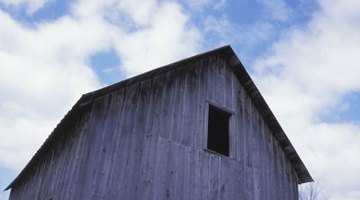How to Rig a Barn Pulley
Barn pulley systems are designed to load heavy items from the main area of the barn to either the loft or haymow. Older designs used a horse as a pull mechanism to operate the ropes, then a pulley system would lift loads of hay and run down a track to the loft or haymow. Operating in much the same way today, the system can work with a modern powered winch to move the hay or other items.

-
Position the carrier in the center of the slide rail that extends the length of the barn.
-
Suspend the main pulley on the hook below the carrier. Configure 4 draft pulleys in a feeder type system to guide the cable or rope from the lifting mechanism and counterweight on either side of the track, up through the main pulley. This means mounting a draft pulley at each end of the track and a second pair -- one on each side -- about mid-height between the track and the location where the pulling mechanism and counterweight will be.
-
Secure a final draft pulley down low at the level of the pulling mechanism to make a level line from this pulley, to whatever will pull the rope, for example a horse, winch, or 4-wheel RV.
-
Thread the heavy-duty rope or cable through first the lowest pulley near the pulling mechanism, then the draft pulley on that side of the track. Run the cable or rope along the track to the main pulley and thread it on one side, below the pulley -- not above.
-
Run the cable or rope along the remaining track to the draft pulley at the end, then down to the lower draft pulley on that side of the rig. Attach the weight to that end of the rope.
-
Thread the secondary rope or cable through the main pulley on the other side of the existing rope, this one going up and over the pulley. Do not cross these lines. When the pulling mechanism moves the main cable, this secondary rope or cable will rise and fall according to the action of the pulley.
-
Attach the front end of the main cable or rope that does not have the weight attached to it to the pulling mechanism. As the cable or rope is pulled, the secondary cable or rope will rise as the pulley spins. The object can then be moved along the track to the desired location and lowered by reversing the pulling mechanism.
References
Writer Bio
Caprice Castano recently left the field of construction management to operate her own contracting business and spend time developing her writing career. Current projects include freelance writing for Internet publications and working on novel-length fiction.
Photo Credits
- Hemera Technologies/AbleStock.com/Getty Images
More Articles



